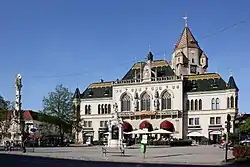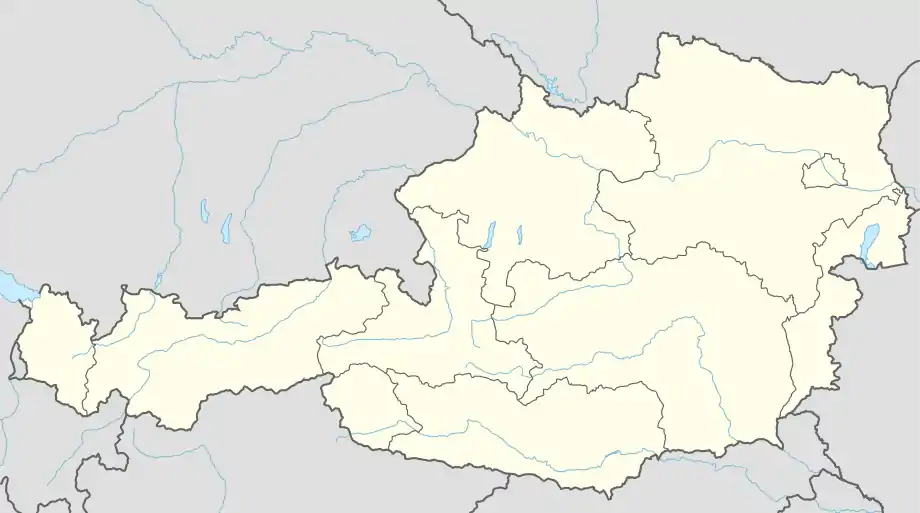Korneuburg | |
|---|---|
 Town hall of Korneuburg | |
 Coat of arms | |
 Korneuburg Location within Austria | |
| Coordinates: 48°20′43″N 16°19′59″E / 48.34528°N 16.33306°E | |
| Country | Austria |
| State | Lower Austria |
| District | Korneuburg |
| Government | |
| • Mayor | Christian Gepp[1] (ÖVP) |
| Area | |
| • Total | 9.77 km2 (3.77 sq mi) |
| Elevation | 168 m (551 ft) |
| Population (2018-01-01)[3] | |
| • Total | 12,986 |
| • Density | 1,300/km2 (3,400/sq mi) |
| Time zone | UTC+1 (CET) |
| • Summer (DST) | UTC+2 (CEST) |
| Postal code | 2100 |
| Area code | 02262 |
| Vehicle registration | KO |
| Website | Stadt Korneuburg (in German) |
.JPG.webp)
Korneuburg (German pronunciation: [kɔʁˈnɔʏbʊʁk] ⓘ) is a town in Austria. It is located in the state Lower Austria and is the administrative center of the district of Korneuburg. Korneuburg is situated on the left bank of the Danube, opposite the city of Klosterneuburg, and is 12 km northwest of Vienna. It covers an area of 9.71 square km and, as of 2001, there were 11,032 inhabitants.
Korneuburg was originally a bank settlement associated with Klosterneuburg under the name Nivenburg. It was first mentioned in 1136, and in 1298 received the right to formal separation from Klosterneuburg.
In 1938, the shipyard Korneuburg was integrated into the Hermann-Göring-Werke, and significantly enlarged. In 1941, 16 barracks for Germans, forced laborers and prisoners of war were added. In 1945, the Red Army captured the shipyard.[4]
Military campaigns involving the city include the Battle of Vienna, the Thirty Years' War, the French Revolutionary Wars, and the Oil Campaign of World War II.
The Korneuburg Shipyard is now the site of a branch of the Museum of Military History, Vienna comprising two patrol boats, Niederösterreich and Oberst Brecht. These were the Austrian Army's last patrol ships on the Danube, and the successors of the KuK Kriegsmarine.[5]
Population development
- 1900: 8,292
- 1939: 9,893
- 1971: 9,023
- 2012: 12,267
People
- Johann Georg Lickl (1769–1843), Austrian composer
- Rudolph Philip Waagner (1827–1888), civil engineer
- Max Burckhard (1854–1912), director of the k.k. Hofburg Theater (Viennese Burgtheater)
- Nikolaus "Nico" (Josef Michael) Dostal (1895–1981), Austrian Operetta and film music composer
- Viktor Matejka (1901–1993), Austrian writer, politician
- Edith Hörandner (1939–2008), folklorist
- Kurt Binder (1944-2022), Austrian physicist
- Helmuth Lehner (born 1968), singer and guitarist of the blackened death metal band Belphegor
- Mario Majstorović (born 1977), footballer
References
- ↑ Im Fokus: Wolfgang Peterl (german) Interview of the KO2100 Korneuburg Community
- ↑ "Dauersiedlungsraum der Gemeinden Politischen Bezirke und Bundesländer - Gebietsstand 1.1.2018". Statistics Austria. Retrieved 10 March 2019.
- ↑ "Einwohnerzahl 1.1.2018 nach Gemeinden mit Status, Gebietsstand 1.1.2018". Statistics Austria. Retrieved 9 March 2019.
- ↑ Anna Rosmus Hitlers Nibelungen, Samples Grafenau 2015, pp. 180
- ↑ "Boatpatrol Korneuburg". Heeresgeschichtliches Museum. Archived from the original on 21 October 2016. Retrieved 23 October 2016.
External links
- . Encyclopædia Britannica. Vol. 15 (11th ed.). 1911.
- KO2100 Korneuburg Community
- Website
- "Municipal data for Korneuburg". Statistik Austria.
- Entry about Korneuburg in the database Gedächtnis des Landes on the history of the state of Lower Austria (Lower Austria Museum)
- Revisiting the Transit Camp at Korneuburg after 58 Years